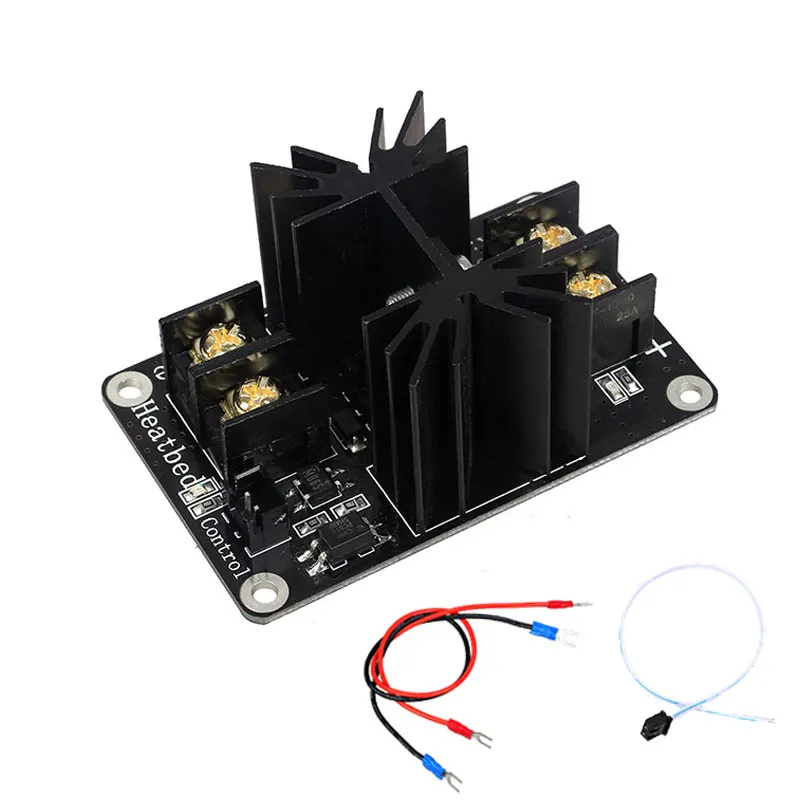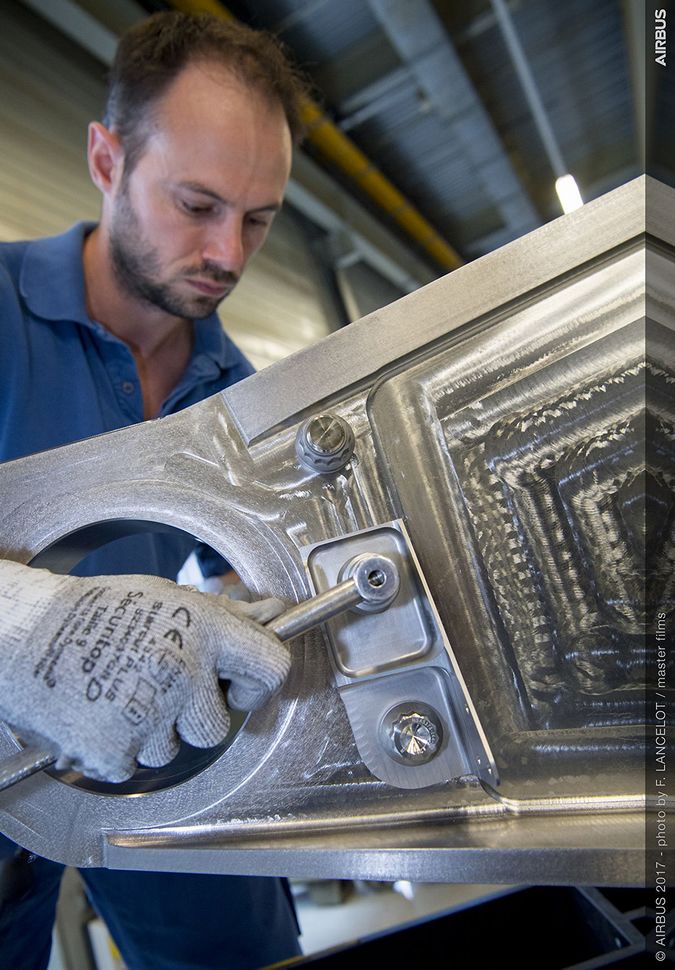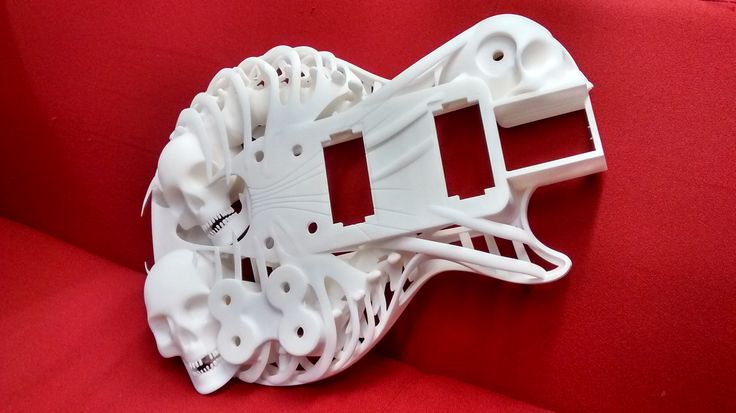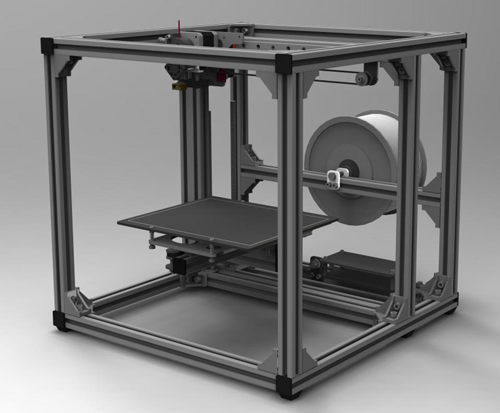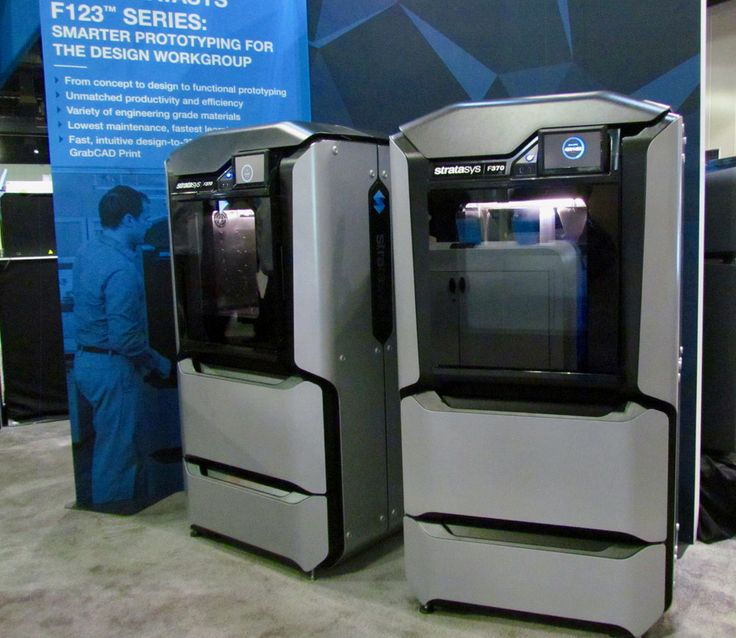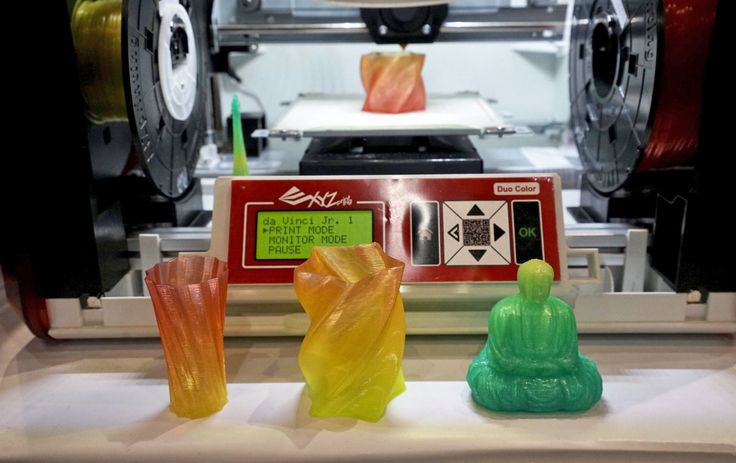Mosfet 3d printing
[GUIDE] Install a mosfet between the power supply and the heated plate
Guides Upgrade
Posted on Author easy3dhome Comment(1)
Post Views: 587
Why install a Mosfet
If you’re new to 3D printing and you’re deciding to buy a printer, or you’ve just finished assembling it, you’ve surely heard of the Mosfet, and you’re wondering: Why should I install a mosfet?
The basic idea is quite simple. The power consumption used to heat the dish goes all through the motherboard, and it’s not a good thing. All the power needed to heat the bed must pass through a single connector. This unique connector must also serve all other parts such as the hotend, steppers and logical drives. The standard connectors are then not sized and designed to be crossed by the energy needed to heat a 30×30 plate to 110°C. So if you want to deal with long prints with the hot plate or you are equipped, or sooner or later you will have to deal with a small fire.
Luckily when it happened to me, the fire extinguished itself. I wasn’t near the printer and there was nothing I could have done. Anyway after this experience I immediately wanted to install a mosfet to my printer!
I talk of heated plate because it is the bed that requires most of the energy. The heating cartridge of hotends normally reaches 40w, more rarely 60w. The board as a whole needs another 50/60 w to power the microcontrollers and the display. Once the set temperature is reached, the energy required by the heating cartridge becomes intermittent and then decreases again. This brings the average consumption of a printer to work with the plate off to about 80/90 watts/hour. If our power supply is 360w (average size), then we see that more than 250w are hot bed paneling.
So by removing the bed current from the motherboard, you significantly reduce the stress on the motherboard connectors. If wanted we could install a mosfet for the Hotend even if with such low consumption I do not know if it is worth it.
Material required for this purpose:
- Mosfet
- Coloured electric cable
Install a mosfet
For the installation you can certainly start by printing a special bracket to mount the mosfet attached to the card or separate. You can find lots of them on Thingiverse
NOTE: always check the polarities + and – on the cards.
* RED = + (on psu marked as + V)
* BLACK = – (on psu marked -V or COM)
Now act as follows:
- Disconnect the printer power.
- Remove heated bed power cables from the motherboard and connect them to the output power of the MOSFET unit.
- Connect the 2 wires from the motherboard bed output to the MOSFET control input.
- Connect the 2 wires from the PSU to the power input of the MOSFET unit.

Even if the signal is said that it is not important the polarity does not cost anything to put it right, sometimes some mosfets are sensitive to polarity.
I hope that this mini guide has clarified some doubts both on the usefulness and on the installation of the mosfet. Electricity is no joke!
If you have found this post useful, please LIKE on Easy 3D Home Facebook’s page to receive updates on all the news of the Blog! You can find other guides about 3D in our Guides section!
Like this:
Like Loading...
Properly picking and using MOSFETs! – Tom's 3D printing guides and reviews
I often recommend Mosfets over trying to use an SSR in some janky way. Here’s what you’ll need to look out for!
Hey everyone, Tom here, and back when i made the “Solid State Relays” video, i got lots of questions on “well, can i use them for 12V DC heated beds, too?” and while there are DC in, DC out solid state relays, in most cases, a simple MosFET is cheaper, smaller and will perform better.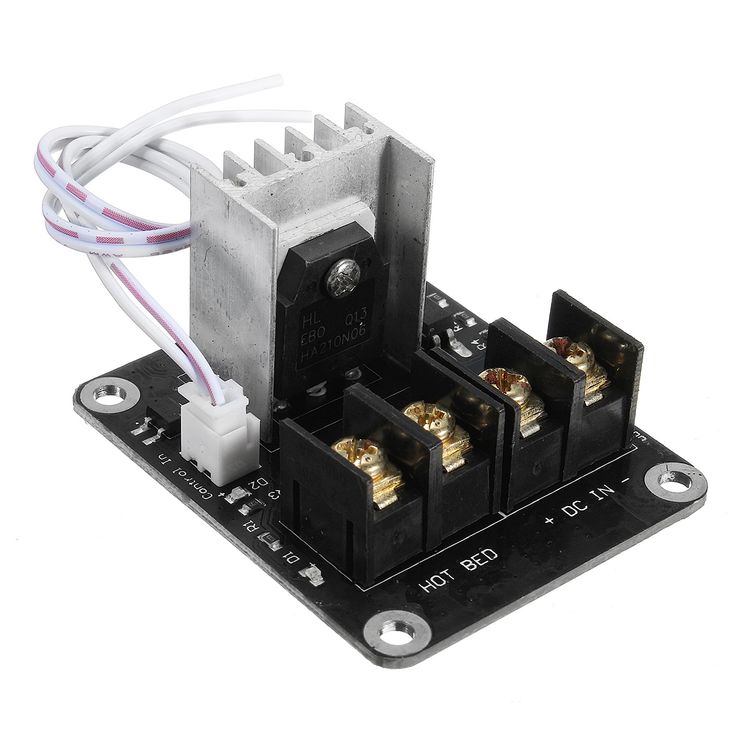 So in this video, you’re going to learn about what makes a good MosFET for the typical 3D printing applications like switching a hotend or bed heater and how to wire it up.
So in this video, you’re going to learn about what makes a good MosFET for the typical 3D printing applications like switching a hotend or bed heater and how to wire it up.
So there’s one big difference between how you can use an SSR and a MosFET, and that’s isolation. With an SSR, there can be an electrical potential of a few thousand volts between the switching and the switched voltage, that’s why you can easily use an SSR to switch mains voltage with an Arduino without having to worry about stuff melting down. On the other hand, the way mosFETs are typically used for switching simple loads requires your control signal and your load to share the same ground potential – so if you have two different supplies for them, like a 5V supply for an Arduino and a 12V supply for your load, you’ll need to have the ground lines of those two supplies connected together. If you can’t do that without damaging something, you’ll need an SSR, but typically, you want to have all ground lines connected to protective earth anyways – which means a simple mosFET will work just fine as well.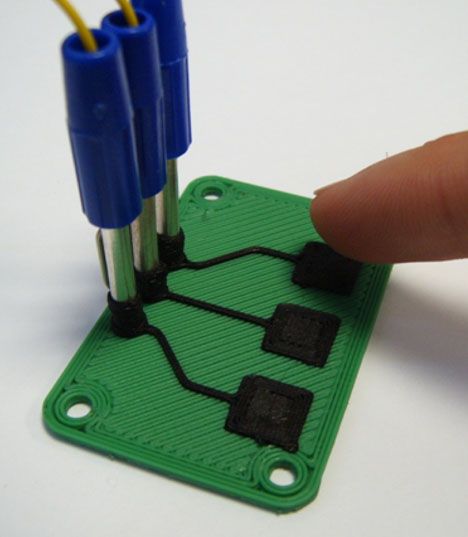
So there are two main parameters you’ll need to know when choosing a MosFET. One is the voltage your load runs at, and the other is the sustained current you want to switch. To gouge if a specific type of mosfet will be able to handle those, you’ll need its datasheet, in my case, as an example, of a common IRLZ44N, and, yes, a datasheet is big and scary and has lot of information you’ll never need, so i’ll try to break it down as simply as possible. So i’m not going to go for 100% perfect technical accuracy, but for “good enough” for 99% of all applications, even if we’re going to take a shortcut here and there.
Now the shortcut i see a lot of folks taking way too often is simply jumping in and seeing the 55V rating and the 47A right below that and going, well, 47A is way more i’ll ever need, so it’s probably going to be fine, right? Wrong. Because it’s not that simple. All that 47A rating says is that the mosFET will not melt down internally at that current if you can provide infinite cooling. And you probably can’t do that, so if you actually push 47A through this type, it’s going to generate more heat that it can dissipate, overheat and melt down within a few seconds due to the internal losses within the package. And most of the time, that’s going to be your limiting factor. So how do you figure out how much a mosFet can actually take? Use the third value up there, which is the internal resistance of the FET when it’s fully switched on. That’s going to determine how much power you’re going to need to dissipate from the mosfet’s package at a given constant load. And constant, for most electronics without huge heatsinks, is longer than about 10 seconds, which you’re easily going to see in any “heater” application. So the R_DS_on, for this particular type is 0.022 Ohms, 22 milliohm, in a perfect world. However, you’re not going to give this transistor a perfect control signal and there are other factors that degrade this rating as well, so it’s probably not a bad idea to calculate with a 20% to 30% worse value here.
And you probably can’t do that, so if you actually push 47A through this type, it’s going to generate more heat that it can dissipate, overheat and melt down within a few seconds due to the internal losses within the package. And most of the time, that’s going to be your limiting factor. So how do you figure out how much a mosFet can actually take? Use the third value up there, which is the internal resistance of the FET when it’s fully switched on. That’s going to determine how much power you’re going to need to dissipate from the mosfet’s package at a given constant load. And constant, for most electronics without huge heatsinks, is longer than about 10 seconds, which you’re easily going to see in any “heater” application. So the R_DS_on, for this particular type is 0.022 Ohms, 22 milliohm, in a perfect world. However, you’re not going to give this transistor a perfect control signal and there are other factors that degrade this rating as well, so it’s probably not a bad idea to calculate with a 20% to 30% worse value here. Multiply that by the current it will need to switch, squared and you’ll get the thermal power generated in the mosfet, in watts. So for a typical 12V cartridge heater with about 4A, that’s roughly .4W of heat that the IRLZ44N will turn into heat, for a 12A heater PCB, it comes out to 3.8W. Because the current is squared here, having three times the current actually makes for a factor of 9 when it comes to thermal losses. Now, these losses also need to escape the package somehow, and the datasheet also gives you a value for that, which is the thermal resistance, junction-to-ambient if you’re not using a heatsink. If you do have one screwed to the transistor, use its datasheet value for the thermal resistance instead. That value basically tells you how much the package will heat up for each watt of thermal losses, so in this case, without a heatsink, it’s 62°C for each watt. So for the .4W with the heater cartridge, no heatsink and no airflow, it’s going to heat roughly 25°C beyond ambient for a total of 45 to 50°C.
Multiply that by the current it will need to switch, squared and you’ll get the thermal power generated in the mosfet, in watts. So for a typical 12V cartridge heater with about 4A, that’s roughly .4W of heat that the IRLZ44N will turn into heat, for a 12A heater PCB, it comes out to 3.8W. Because the current is squared here, having three times the current actually makes for a factor of 9 when it comes to thermal losses. Now, these losses also need to escape the package somehow, and the datasheet also gives you a value for that, which is the thermal resistance, junction-to-ambient if you’re not using a heatsink. If you do have one screwed to the transistor, use its datasheet value for the thermal resistance instead. That value basically tells you how much the package will heat up for each watt of thermal losses, so in this case, without a heatsink, it’s 62°C for each watt. So for the .4W with the heater cartridge, no heatsink and no airflow, it’s going to heat roughly 25°C beyond ambient for a total of 45 to 50°C. With the load from a PCB heated bed, you’d end up with a rise of 236° and a total of almost 250°C. Now don’t get me wrong when i say the mosFET will probably keep working at those temperatures beyond its rated maximum of 175°C, but it’s also probably going to desolder itself or light some stuff one fire. Not cool. In quite a few different way, actually. So in this case you’re either going to need a heatsink or a better mosfet with a lower DC resistance.
With the load from a PCB heated bed, you’d end up with a rise of 236° and a total of almost 250°C. Now don’t get me wrong when i say the mosFET will probably keep working at those temperatures beyond its rated maximum of 175°C, but it’s also probably going to desolder itself or light some stuff one fire. Not cool. In quite a few different way, actually. So in this case you’re either going to need a heatsink or a better mosfet with a lower DC resistance.
Now, the other thing you’ll need to look out for are the necessary drive levels for the Mosfet. The IR*L*Z44N is a logic-level type, which means it should reach the specified on resistance at least when it’s driven from a 5V source, so e.g. any of the common Arduino-based boards. Other boards, like more modern ARM-based ones like the Smoothieboard or Replicape, are 3.3V systems and consequently also only provide roughly 3.3V for driving a mosfet, so watch out for that. You can verify how well a mosfet will do with a specific drive voltage, again, in the datasheet, with the static drain-source-resistance at your specific drive voltage, so e. g. 5V, or, more realistically, 4.5V here. You can see that, with a 5V drive, the guaranteed on resistance already jumped to 25 milliohm compared to the front-page rating of 22, which only applies when you use a full 10V to drive it, and if your drive voltage drops down from the full 5V, the mosfet’s resistance will rise even further. By the way, this is the resistance value you should be using when calculating the losses inside the transistor, hence the 20% “fudge factor”.
g. 5V, or, more realistically, 4.5V here. You can see that, with a 5V drive, the guaranteed on resistance already jumped to 25 milliohm compared to the front-page rating of 22, which only applies when you use a full 10V to drive it, and if your drive voltage drops down from the full 5V, the mosfet’s resistance will rise even further. By the way, this is the resistance value you should be using when calculating the losses inside the transistor, hence the 20% “fudge factor”.
If we compare this to the much cheaper IR*F*Z44N, which is not a logic level type, but still used, incorrectly, for that application way too often, we’ll see that it doesn’t even have a rating for a 5V drive. So this guy will waste a lot of power and get really hot if it needs to drive something like a heated bed with a 5V control signal.
So that’s how you can verify if a mosfet is a good choice or not for a specific application. As a good “basic” choice, the IRLZ44N will work fine for any load in the same ballpark as a hotend, the only # slightly more expensive IRF3708 will do a good job even for more demanding loads like a typical heated bed.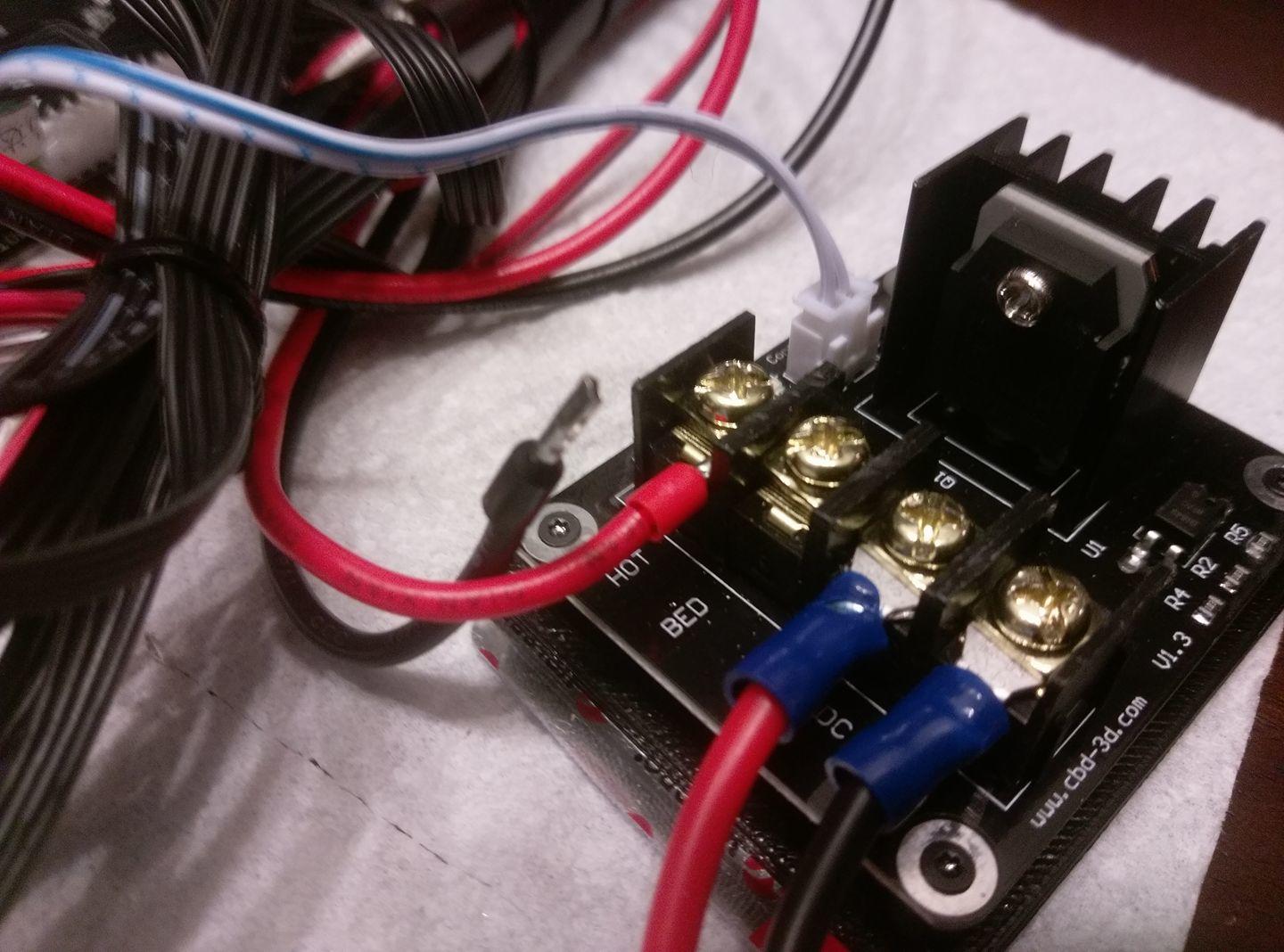 Or, if you need something a bit more hardcore, grab the IRLR8743, which gives you an even lower on resistance, but is not commonly available in the convenient through-hole packages like TO220.
Or, if you need something a bit more hardcore, grab the IRLR8743, which gives you an even lower on resistance, but is not commonly available in the convenient through-hole packages like TO220.
So, how do you wire it up? I mean, it only has three pins, there’s not much that can go wrong. Typically, those three pins are gate, drain, source. Basically, gate is your control port, drain is where, figuratively, the current will drain into, and source it where it comes pouring out again. For the N-channel type mosfets we’ll be using, when the mosfet is turned off, it will block current from flowing from drain to source, when it’s on, it will allow current to flow through. To turn it on, the gate needs to be at a significantly higher voltage than the drain, and to turn it off, at about the same or lower voltage relative to the drain. The exact levels vary depending on which exact mosfet you choose. So what we are going to and actually pretty much all RepRap control boards are using is called low-side switching, where we’ll disconnect our load from the ground line, so in the on-state, of course we’ll have current flowing through this entire thing, but when we turn it off, because the current can now not flow through the mosfet, the mosfet’s drain will charge up through the load to the voltage level of the supply voltage.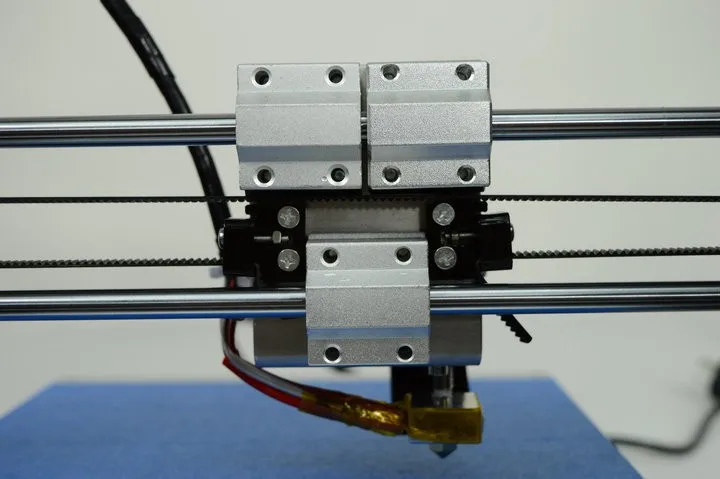
So that’s how it should be wired up: Gate goes to your microcontroller’s output pin, if you want it to be really perfect, you can add a 10 to 100 Ohm resistor in series here, then the drain goes to the negative terminal of your load, while the source goes directly to ground. Also, very important, is a pulldown resistor on the gate, typically somewhere around 10k, you can solder this one directly across the Mosfet’s body and it will protect it from going into an undefined state where the Mosfet will mostly work as a resistor and… burn up. Lastly, the positive terminal of your load goes directly to the supply voltage.
And that’s really all there’s to it. So, again, there are only very few cases where you’ll need a DC-DC solid state relay, and most of the time, a Mosfet is the better and cheaper choice as long as you pick a decent one.
As always, thanks for watching, rate, comment, subscribe.
Music is Tobu – Colors
Welcome to NIOZ.RU
Sort by
Product Name +/-
Product Price
Featured Products
Product Availability
Displaying 1 - 60 of 621
153060150
Products
400 ml
RUB 1940. 00
00
Product description
RUB 390.00
Product description
350 ml
RUB 850.00
Product description
Ready to print
RUB 23700.00
Item description
Ready to print out of the box
RUB 14500.00
Notify me when available
Product description
Print ready
RUB 20900.00
Notify me when available
Product description
Ready to print out of the box
RUB 43500.00
Product description
Ready to print
RUB 39000.00
Item description
LCD 0.7/1.75 mm
RUB 1550.00
Notify me when available
Product description
RUB 650.00
Product description
Wiznet W5100 Arduino Shield
RUB 650.00
Report Admission
Product description
RUB 550.00
Product description
Assembly kit
RUB 2500.00
Notify me when available
Product description
Volume: 1 l.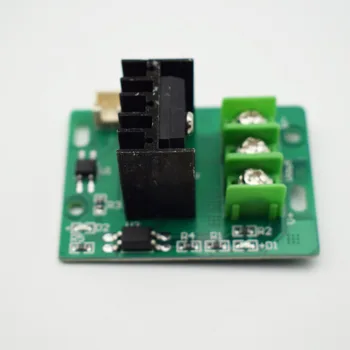
RUB 3100.00
Product description
Boscam 200mW, 5.8GHz
Chimera, e3d
RUB 1700.00
Product description
Print head 1.75mm 0.4mm
RUB 1100.00
Product description
Double printhead 1.75mm 0.4mm
2500.00 RUB
Notify me when available
Product description
Long
RUB 750.00
Item description
Short
RUB 700.00
Product description
RUB 1900.00
Notify me when available
Product description
APM2.6 mavlink
RUB 1350.00
Product description
RUB 250.00
Product description
11.1V, 20C
RUB 1900.00
Item description
11.1V, 25C
RUB 1250.00
Notify me when available
Product description
11.1V, 25C
RUB 2100.00
Product description
Heat block v6
RUB 150.00
Item description
cartridge type thermistor
Heat block Volcano
RUB 170.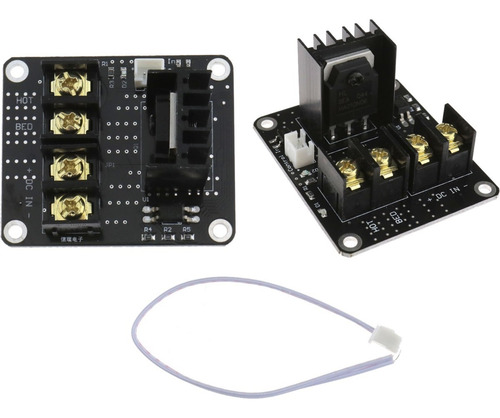 00
00
Product description
48V 12A
RUB 2700.00
Notify me when available
Product description
12V 20A
RUB 1550.00
Product description
12V 30A
RUB 1950.00
Notify me when available
Product description
12V 5A
RUB 450.00
Report Admission
Product description
24V 15A
RUB 2100.00
Notify me when available
Product description
RUB 250.00
Product description
Hobbed bolt
RUB 150.00
Item description
Price per 10mm (free cutting)
RUB 13.00
Product Description
Price per 10mm (free cutting)
RUB 17.00
Product description
Section 400mm
RUB 650.00
Product description
Price per 10mm (free cutting)
RUB 25.00
Product Description
10mm (cut to size)
RUB 70.00
Item description
10mm (cut to size)
RUB 90.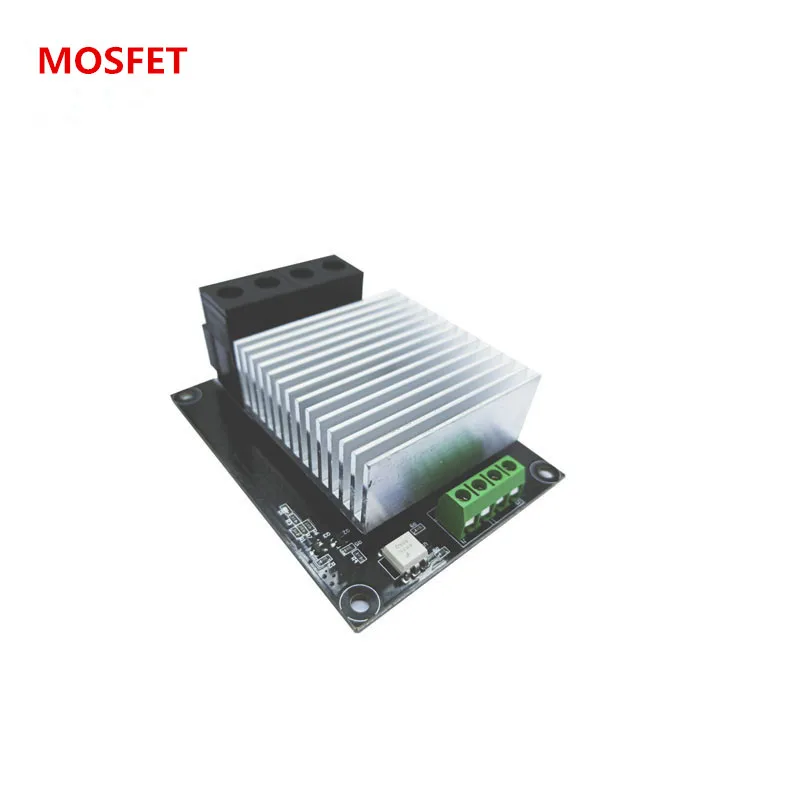 00
00
Product description
Price per 10mm (free cutting)
RUB 7.00
Product description
Price per 10mm (free cutting)
RUB 10.00
Item description
Section 400mm
RUB 400.00
Product description
2x400mm, 2x350mm, 2x325mm
RUB 2100.00
Product description
2x420mm, 2x405mm, 2x350mm, 1x20mm
RUB 2200.00
Product description
25x25x10mm
RUB 150.00
Product description
25x25x10mm
RUB 150.00
Product description
30x30x10mm
RUB 150.00
Product description
30x30x10mm
RUB 150.00
Product description
40x40x10mm
RUB 150.00
Notify me when available
Product description
40x40x10mm
RUB 150.00
Product description
50x50x10mm
RUB 150.00
Notify me when available
Product description
50x50x15mm
RUB 150.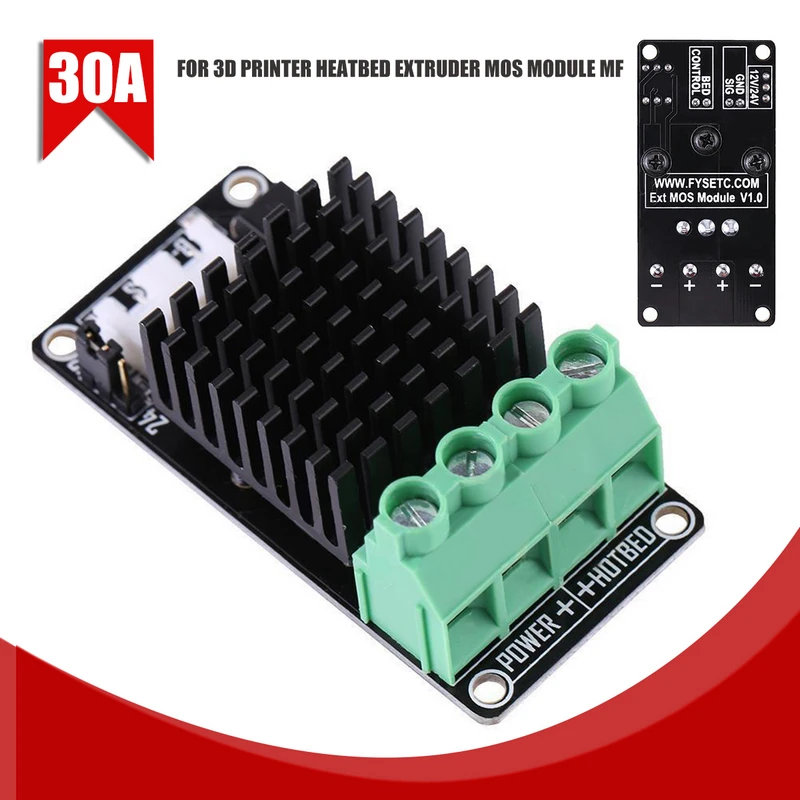 00
00
Product description
50x50x15mm
RUB 150.00
Product description
50x50x15mm
RUB 150.00
Product description
Turbine 40x40x10mm
RUB 250.00
Product description
Turbine 40x40x10mm
RUB 250.00
Product description
Turbine 40x40x20mm
RUB 250.00
Product description
characteristics, photos and customer reviews
675.93 ₽The product is not available now, look similar
Go to the storeThe product is no longer sold, look similar
Link copied, share it
Or send via social networks
- On the site for more than 3 years
- Poor overall rating (629)
- Customers satisfied
- description
- Sends goods quickly
- 1.
 2% of customers were dissatisfied in the last 3 months
2% of customers were dissatisfied in the last 3 months
This product is not currently available, but there are similar and similar
The price decreased by 32.32 ₽
Cheaper than average, slightly-5
%
Reliable seller - 83%
Above average, can be bought, Creativeing 3D printer Store
Prices from other sellers from 375.44 ₽
979.17 ₽
3D Printer Parts Hot Bed Heating Controller MKS MOSFET for Heat Bed/Extruder MOS Module Exceeds 30A Support Large Current
0 OTO TELO
0 PrOSA
Reliability-72%
Seller SSDOLVLO Global Store
In the store
508.15 ₽
spare parts for a heating plate/Extra exceeds 30A, high current support
0ratings
0orders
100% reliable
Seller Hong Kong feng tai co., LTD
Go to shopGo to shop
Rs. Seller Hong Kong feng tai co., LTD
Go to storeGo to store
Found 46 similar items
2
1
Reliability of the seller 89%
30a MOS MOS MOSFET MOS MOS MOST for 3D printer HeATBED Extruder MF
1
3
Seller's reliability 89%
9000 334. 18-750.20 ₽ 9000 HW-300 30A MKS MOSFETER, TERMOPORTOR , mop module
18-750.20 ₽ 9000 HW-300 30A MKS MOSFETER, TERMOPORTOR , mop module 2
3
Reliability of the seller 51%
-1
%
2 893 ₽
3d printer parts, mosfet heating controller for thermal platform/extruder, 30a mosfet module, high current support for tevo blv mgn cube, 5 pcs.
1
1
The reliability of the seller 89%893.22 ₽
3D printer Heating controller High current load MOS MODUL MODUL MOSFET BECTIC AND 30A
Reliability of the seller 83%
-2
%
541.85 ₽
High -power mop -module for an expansion platform, extruder with a heating controller MOSFET MKS, large current 30 A, spare parts for SKR Board 3D Pinter
2 9000
Sales 83 Reliable seller0003
979. 17 ₽
17 ₽
High-power heating controller for MKS mos module HeatBed Controller for Tevo BLV MGN Cube 3D Printer
0
0
Resetty to the seller 68%
1,209 ₽
2 pcs. , mosfet heating controller, mosfet board heatbed/extruder 30a for ramp1.4 tevo blv mgn cube 3d printer
0
0
0003
3d printer parts heating controller mop module heat board mosfet/extruder 30A 5-24V for ramp1.4 tevo blv mgn cube 3d printer
2
4
Reliable seller 89%
3-3
%
228.29 ₽
3d printer parts, heated platform / extruder power module, exceeds the maximum current of 25 µs, MOSFET for heating controller ramps 1.4
9 1
3 3
2 Reliability seller 100% 315.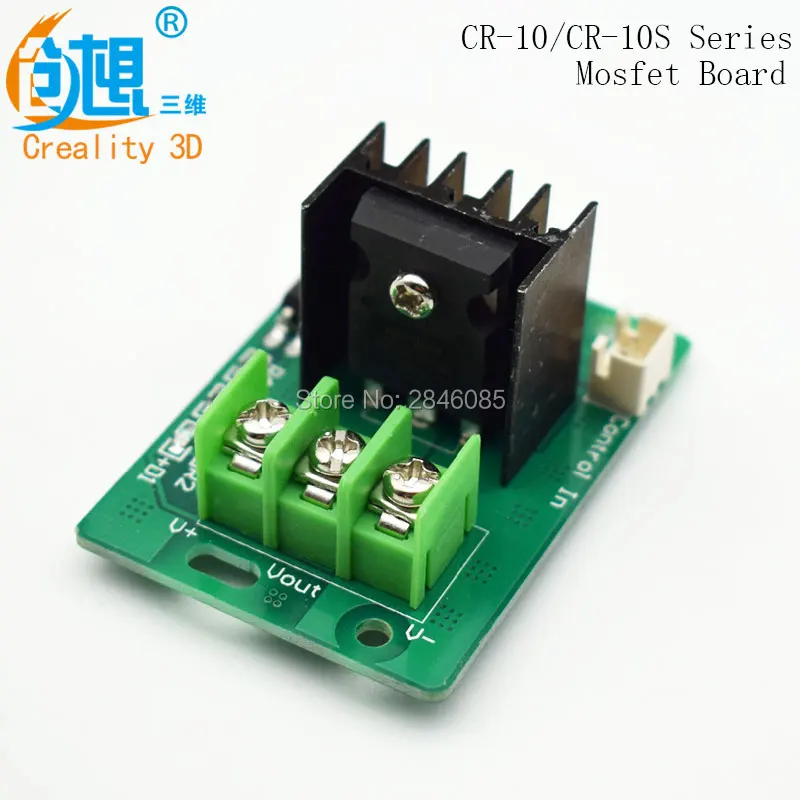 62 ₽
62 ₽
2pcs 3D Part Press Part of thermal Service Module heat generator 50x50x20 mm for RAMP1.4 Tevo Mosfet Board of Parts Parts
0
0
Reliability of the seller 100%
247.54 ₽
9000 3d Mosfet heater for heating plate, mosfts module, high current transistor, mos, feta oxide, semiconductor3
7
dlion heating controller mos module non-polar drive control interface high current hot bed power expansion board
0
0 9000
3d printer accessories mosfet heated power module mks for anet a8 a6 a2 prusa i3 gdeals
0
0
0003
249.61 ₽
Accessories for the 3D printer MOSFET FEAR NOW MODUL MKS for ANET A8 A2 A2 PRUSA I3 EM88
0
0
Reliability of the seller 89 %
% 9000 245. For the Mosfet 3D printer, a heated power module MKS for ANET A8 A2 A2 Prusa i3 JR Supply
For the Mosfet 3D printer, a heated power module MKS for ANET A8 A2 A2 Prusa i3 JR Supply
0
0
Seller's reliability 85%
305.30 ₽
Etmakit accessories for 3D printer MOSFET MODULATION MODULA a6 a2 prusa i3 nk shopping
0
0
Reliability of the seller 85%
1
0
Seller Reliability 100%
522.59 ₽
Creative3d remote extruder kit 3d printer direct drive extruder parts 3d printer parts v6 j-head kite e3dv6 nozzle heater block
1
1
Reliability of the seller 83%
-4
%
3 160 – 4 068 ₽
MARLIN2.0, triple extruder
0
3
Reliability of the seller 100 %
-0.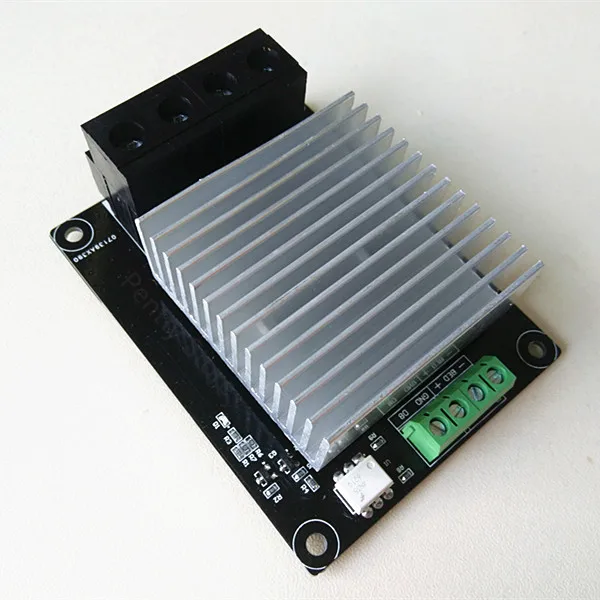 6
6
%
110.02 ₽
3D printer Hot bed/MOS high load module/Module of the Heating of Power Power Power Power Power0003
2
4
Reliability of the seller 100 %
-5
%
312.87 ₽
Hot Model of the Mosfet High -voltage Module 12V or 24V for 3D printer
9000 0
Reliability of the seller 100%
-0.8
%
0003
0
0 9000 seller 83%
-5
%
237.23 ₽
Mos heating controller for heated bed mos module mosfets high current transistor mos fet device metal oxide semiconductor
2
2
The reliability of the seller 100 %
-2
%
253.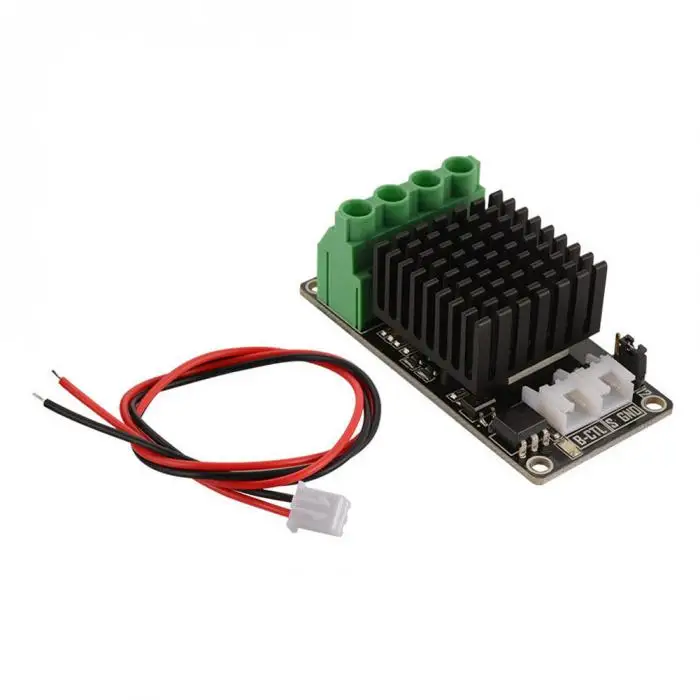 73 ₽
73 ₽
2
0
Seller reliability 83%
-6
%0003
1
1
The reliability of the seller 85 %-26
%
3 644 ₽
Maternal Printer KP3S, for the 3D printer MKS TMC 2225, a quiet Dreiver module, a chalk driver, replacement TMC22088
4
7
The seller's reliability 100 %
-9
%
242.73 ₽
9000 mk8 Assembled Hot end set for Ender -3 printer 0.4 mm Printer Printer Printer Aluminum Heating Block 3D 3D 3D 3D printer accessories1
3
Reliability of the seller 72%
1
2
Seller Reliability 55%
-10
%
224.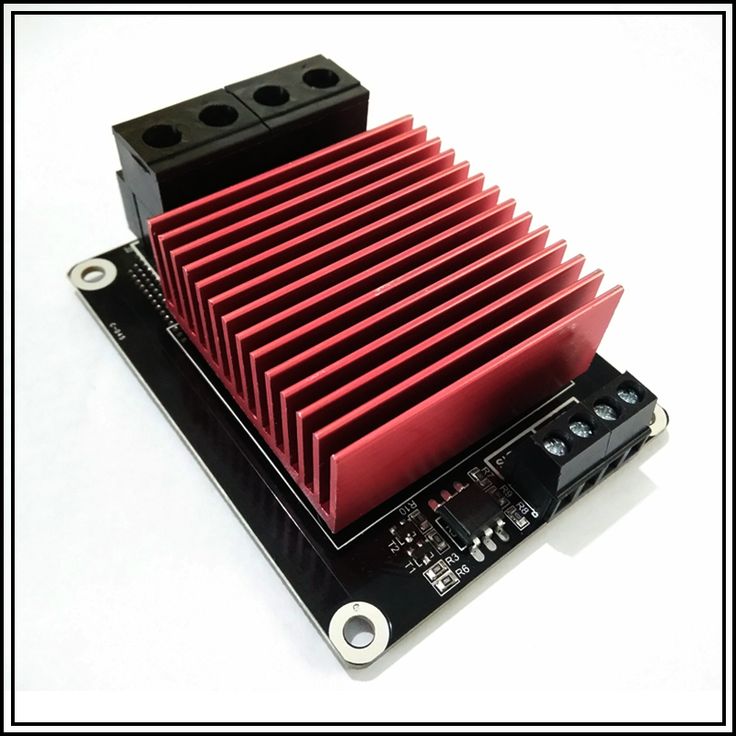 16 ₽
16 ₽
9 0
1
The reliability of the seller 100 %
-3
%
68.07 -204.91 ₽
3D Print aluminum unit for mk7/mk8 Extruder Thermal Head Head Head Head Head Head Model. 1
1
Seller Reliability 83%
163.65 ₽
3d printer heated bed power module high current 20a mosfet upgrade ramps 1.4 expansion module for 3d printer
1
2
The reliability of the seller is 100%
107.96 ₽
Module for the heating platform for the SIMPZIA 3D printer, the total additional module of the MOSFET heating platform, the high-precision load module
1 9000
1
Reliability of the seller 85%
152.65 – 162.97 ₽
3d printer heated high current power module 210a mosfet upgrade ramps 1.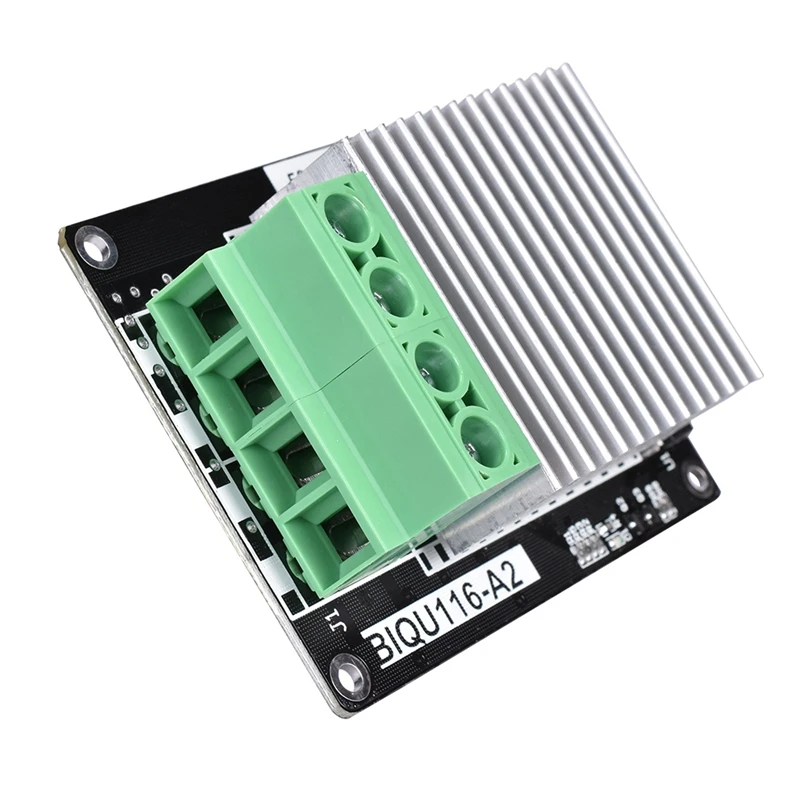 4
4
1
2
3
The reliability of the seller 9 %
-22
%
212.48 ₽
3D printer of high current power 210a Mosfet Upgrade Ramps 1.4
9000 9000 9000 9000 9000 9000 9000 9000 9000 89%-2
%
10pcs/lot 3d heatsink fin aluminum cooling block 27*20*12mm for cr-10s 3d printer mk10 extruder heating block
90399 1Seller Reliability 83%
-5
%
420.82 ₽
30a 12v-50v 3d printer
0
0
Reliability of the seller 100%
3 369 – 3 857 ₽
+ mks wifi module cheap 3d printing parts
1
4
Reliable seller 100%
Incomplete data
or 24 V, details for 3D printer
2
1
The seller’s reliability 0 %
-2
%
83.